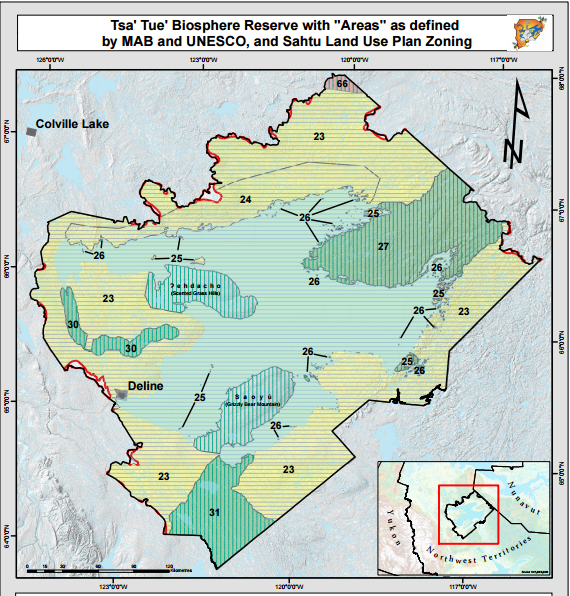Canada’s First UNESCO International Biosphere North of 60

“I recognize the important role that protected areas play in helping to mitigate the impacts of climate change by protecting and restoring healthy, resilient ecosystems and contributing to the recovery of species at risk.” The Honourable Catherine McKenna, Minister of the Environment and Climate Change.
The Dene people of Deline celebrated the Tsá Tué UNESCO International Biosphere Reserve’s official induction to the World Network of Biosphere Reserves earlier this month. This was not only a huge step for northern Indigenous peoples, as this is the first designation granted to a project entirely led by Indigenous peoples, but also a huge step for Canada, as this is the first Biosphere Reserve north of 60 degrees. Therefore this is a recognition of the importance of the United Nations Declaration on the Right of Indigenous Peoples in a real life setting outside the offices of the UN as well as an international appreciation of the importance of northern regions and sustainable development in the fight against climate change.
Tsá Tué UNESCO International Biosphere Reserve
What is a UNESCO Biosphere and why is this one particular one so important? The title itself is non-regulatory and is a method of showcasing areas of the world where people are living sustainably and their lifestyles are recognized as an opportunity for the rest of the world to learn. Including the new group of Biosphere Reserves, added in March of this year, there are 669 across the globe. This particular Biosphere is monumental for several reasons, not limited to the fact that this is the first such project run entirely by Indigenous peoples, includes the protection of one of the last pristine lakes in the Arctic is the new largest Biosphere in North America, but also because it is the first Canadian UNESCO Biosphere Reserve north of 60 degrees. Furthermore, it recognizes that the Canadian north is indeed a place worth protecting, and more importantly that sustainable living in the north should be recognized and celebrated as a method of protecting the region.
"As the elders would say, we're going to be the voice for the lake. The lake can't speak for itself, we're going to speak for the lake." said Gina Bayha the co-ordinator of Tsá Tué International Biosphere Reserve, to the CBC in a recent interview.

Great Bear Lake, the eighth largest lake in the world, has long had significance in the culture of the Dene peoples living in Deline. The lake itself, which falls within the Biosphere Reserve, is also home to numerous flora and fauna, including: trout, moose, caribou, grizzly bears, geese, arctic char, and arctic grayling. This designation is international recognition that the Dene people are the stewards and protectors of this region and that they have done so in a manner that should be celebrated.
In a recent interview with HNN, Stan Boychuk, the Chair of the Canadian Commission for UNESCO National Committee on Man and the Biosphere emphasized the recent significance that the Congress of Biosphere Reserves and the International Coordinating Council for UNESCO has placed on the role of Indigenous peoples. The Man and Biosphere (MAB) Strategy, adopted in Lima in March 2016, “identifies for the first time language in relation to issues of indigenous rights and title and traditional knowledge.”
The world is finally coming to the realization that Indigenous peoples have long been successful stewards of the environment and it is high time that consulting and benefiting from their knowledge should be common practice. As Mr. Boychuk says, “all nomination plans must have the collaboration and co-creation with the Indigenous communities within the geographic region of the proposed biosphere or the nomination will not be considered by the national MAB committee.”
What Does this Mean for Climate Change in the North?
Before the addition of this new Biosphere Reserve, there were only four reserves above the Arctic circle: Noatak National Preserve, North-East Greenland Biosphere, Laplandskiy Biosphere Reserve, and Taimyrsky Biosphere Reserve. That means there are only two biosphere reserves in Russia, one in Greenland, and one in the United States above the Arctic circle. And although this new Canadian Biosphere Reserev is not completely above the Arctic circle, because it encompasses all of Great Bear Lake, it does indeed cross over into the Arctic region.
According to Mr. Boychuk, “There has been the expression of interest from two [more] communities in northern Canada requesting information regarding the MAB programme and the nomination process.” Although he emphasized that fact that this process is in extremely early stages and it could take years before another northern Canadian UNESCO Biosphere Reserve officially got designation, it shows that there is potential for future international recognition of sustainable living.
Mr. Boychuk further mentioned that, “climate change mitigation is a priority for biosphere reserves [and] there are many good and significant initiative being worked on and implemented in Canada and worldwide through the world network of 669 biosphere reserves in 129 countries.” Ensuring that biosphere reserves are present in the north and around the world could be one of the mitigating factors of climate change the future, areas like the Tsá Tué UNESCO International Biosphere Reserve show the positive relationship that humans can have with nature and how important it is for humanity to maintain and protect that relationship. Luckily the Dene people of Deline have shown their care for their beautiful surroundings and now generations to come will be able to enjoy the last pristine lake in the Arctic.
